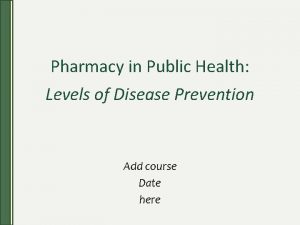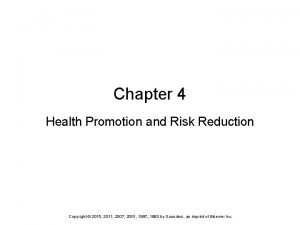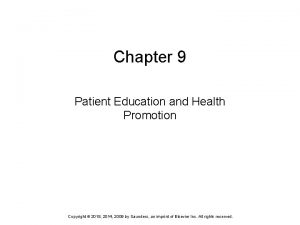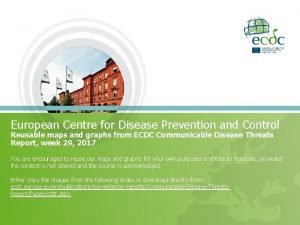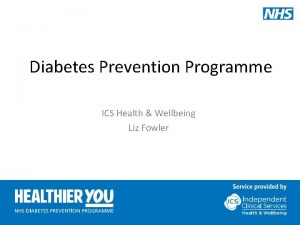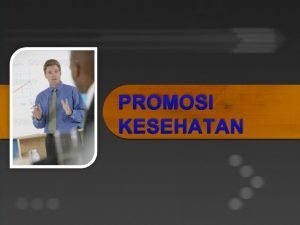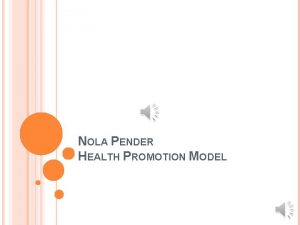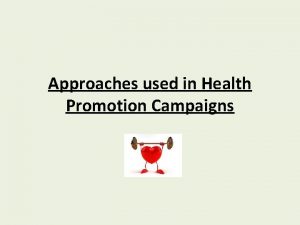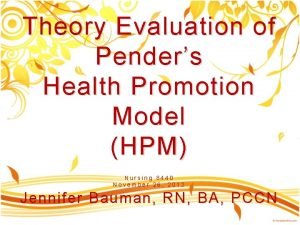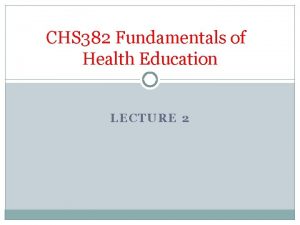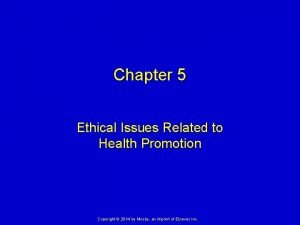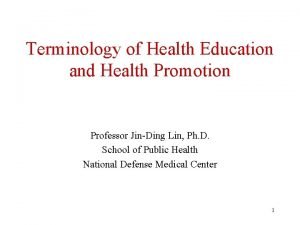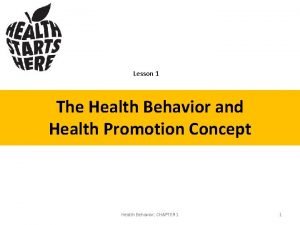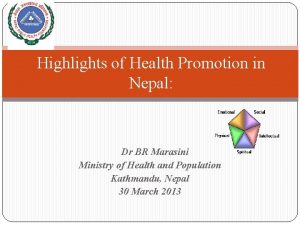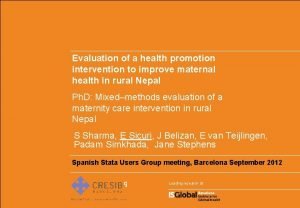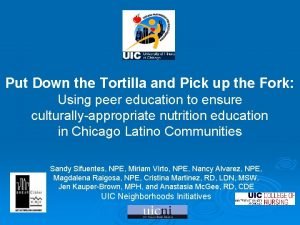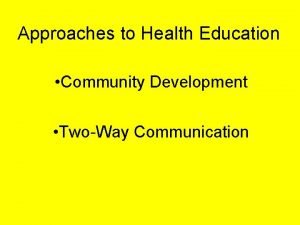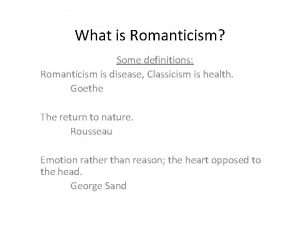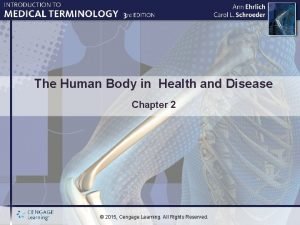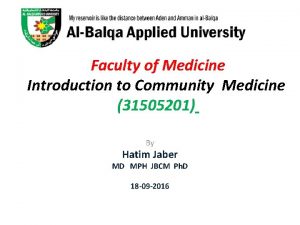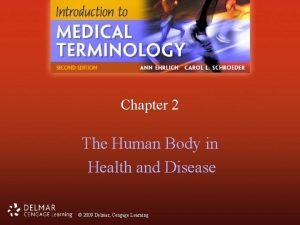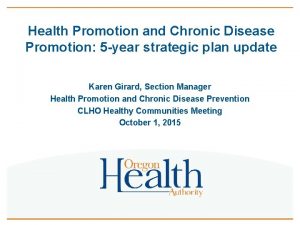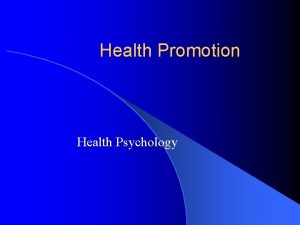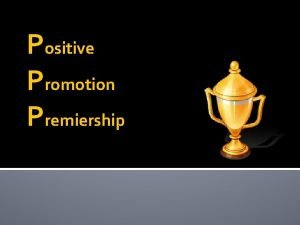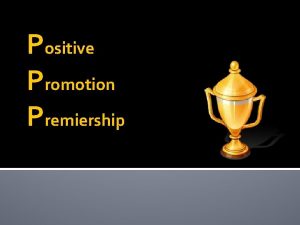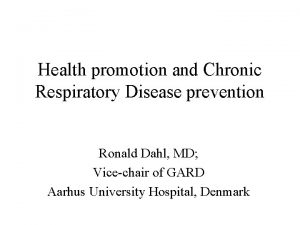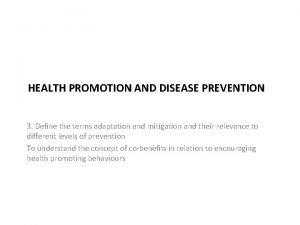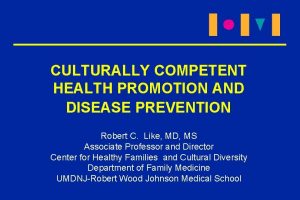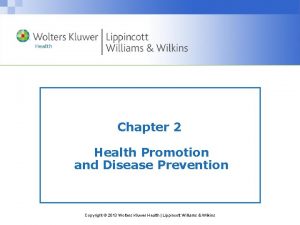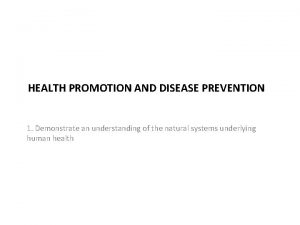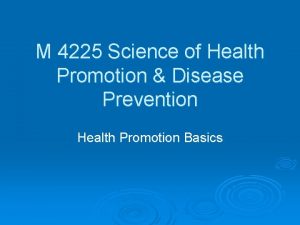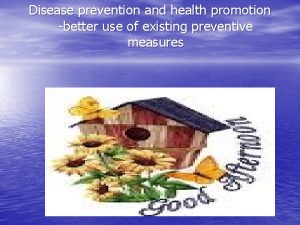Health promotion evaluation Health education evaluation Disease prevention







































- Slides: 39











Λέξεις - Κλειδιά Health promotion + evaluation Health education + evaluation Disease prevention + evaluation Implementation + evaluation Process evaluation Impact evaluation Outcome evaluation Economic evaluation of health programs Health policy adoption Μάθημα 321 - Διάλεξη Νο 7 11






Ορολογία Αξιολόγησης Intervention Program Efficacy Effectiveness Formative evaluation (pilot study) Process evaluation Program impact evaluation (summative evaluation) Health outcome evaluation Internal validity External validity Evaluation research Cost-effective analysis Cost-benefit analysis Μάθημα 321 - Διάλεξη Νο 7 18





Σχεδιασμός προγράμματος & σχεδιασμός αξιολόγησης Why didn’t we think of this before the program began? Good breath, you mean we’ re been teaching breathing exercises to asthma patients, and these exercises have no relationship to improving lung function? I thought this program would lead to fewer hospitalizations, but that outcome was never logically possible! I don’t understand why the medical department won’t cooperate in this program. Μάθημα 321 - Διάλεξη Νο 7 23




Ζητήματα μέτρησης στη συλλογή των δεδομένων ‘’Of course, this measures what I want; just read the sentences, and you can tell’’. ‘I don’t care how the program works, as long as it produces changes in outcomes’. ‘We’ll collect all the measures we can and figure out what to do with them later’. ‘I want all the best measures collected, but we only have a very limited amount of money’ I don’t have the time to access reliability. Let’s assume it’s reliable’. Μάθημα 321 - Διάλεξη Νο 7 27





SPORT EDUCATION & HEALTH: THE FRAME OF A SCHOOL INTERVENTION PROGRAMME Andreas Avgerinos 1, Almond L. 2, Scholl U. 1, Kioumourtzoglou E. 1 1 Dept. 2 Dept. of PE & Sport Sciences, Aristotelian University of Thessaloniki – Greece of PE, Sport Sciences & Recreation Management, Loughborough University, UK Μάθημα 321 - Διάλεξη Νο 7 32

Purpose This experimental intervention programme aimed to a) enhance students’ knowledge on health related (HR) issues and to alter specific behaviours b) promote physical activity and c) increase teachers’ knowledge and effectiveness on HR exercise. The purpose of this poster is to show the frame and the key-considerations of the intervention process. The planing and the implementation of the programme followed the steps: Μάθημα 321 - Διάλεξη Νο 7 33

INTERVENTION PLANNING NEEDS ANALYSIS EVALUATION OF CREATION OF THE FINDINGS SCIENTIFIC TEAM Project 1 COMPONENTS & STRATEGIC OF THE INTERVENTION PROCEDURE OF APPLICATION Project 2 Project 3 Co-operations Setting (s) Programme «Who is the target population? » Stuff - Training Indicators/criteria of succes Key-objectives Founding/Resources Promotion RECORDING EVALUATION & FOLLOW UP Μάθημα 321 - Διάλεξη Νο 7 34

Project 1: Needs Analysis PRELIMINARY DATA Students Inactivity & Young People Psychological Factors Underpinning participation Lifestyle Factors Teachers • Self-efficacy • Attitudes • Knowledge School Profiles A need analysis was carried out in a) a representative cross sectional sample of 950 students from urban areas (11, 14 and 17 years old) b) 103 elementary and secondary PE teachers c) 18 schools. The students answered the “Lifestyle Questionnaire” in order to depict a profile of their PA patterns and habits related to health (dietary patterns, smoking and alcohol consumption). The teachers answered a questionnaire in order to evaluate their knowledge, attitudes and self-efficacy towards teaching HR exercise. A checklist has been used in order to record schools’ provision in sport facilities and audio-visual resources. Μάθημα 321 - Διάλεξη Νο 7 35

Results P r o j e c t 1 Students: a) Physical activity level was below that recommended for good health in the largest proportion of the sample in all age groups. b) Girls were more inactive than boys in all age groups and can be classified as a target population. c) Physical activity declined dramatically over time, especially for girls. d) Students’ knowledge about healthy choices was limited. e) A large proportion of students were regular smokers. Teachers: a) Limited knowledge (58%) on teaching Heath Related Exercise (HRE) b) Very positive attitudes on participating in a Health Education Program (83%) but only 44, 7% were confident (self-efficacy) to overcome the difficulties. Schools: a) Limited provision in extra curricula sport activities. b) Limited provision in sport facilities and audio-visual resources. The results advocated and justified the need Μάθημα 321 - Διάλεξη Νο 7 36 for intervention

Project 2: The Intervention INTERVENTION The intervention strategy focused on: a) The teachers’ training b) The creation and the provision of the necessary resources c) The creation of a positive and enjoyable learning environment for the students and FOCUS ON 1 Students 2 Teachers 3 Curriculum 4 Out of d) The co-operation between school and out of school health co-operation Μάθημα 321 - Διάλεξη Νο 7 and sport alliances. Teachers’ training Resources CDs Audio-visual material Teacher’s Book Student’s Book 37

Method Schools and sample: P r o j e c t 2 The intervention was applied in 9 elementary and 5 secondary schools for a period of 7 months. Fourteen (14) PE teachers involved in the project. A quasi-experimental design with two control groups was applied (experimental group N 1=839 and control group N 2=380). A number of different parameters were measured/estimated at the beginning, in the process and at the end of the program. The intervention process was being monitored in weekly basis by the scientific team and the teachers. Characteristics of the Program: HRE physical education lesson and Health Education Program. Extra curricula activities Co-operation with sport clubs and sport alliances Participation in challenging outdoor activities Μάθημα 321 - Διάλεξη Νο 7 School festival 38

Evaluation of the Intervention Indicators of Success Students • Behaviour • Knowledge • PA patterns • Participation in organised Sport Club PE Teachers • Self - efficacy • Attitudes • Knowledge Schools • Ethos • Resources Μάθημα 321 - Διάλεξη Νο 7 39

 Health promotion and levels of disease prevention
Health promotion and levels of disease prevention Health promotion and levels of disease prevention
Health promotion and levels of disease prevention Primary prevention secondary prevention tertiary prevention
Primary prevention secondary prevention tertiary prevention Difference between health education and propaganda
Difference between health education and propaganda Patient readiness to learn
Patient readiness to learn Chapter 19 disease transmission and infection prevention
Chapter 19 disease transmission and infection prevention Chapter 26 infectious disease prevention and control
Chapter 26 infectious disease prevention and control Chapter 19 disease transmission and infection prevention
Chapter 19 disease transmission and infection prevention European centre for disease prevention and control
European centre for disease prevention and control Chapter 19 disease transmission and infection prevention
Chapter 19 disease transmission and infection prevention Health maintenance and promotion
Health maintenance and promotion Pet 3351 ucf
Pet 3351 ucf Bharathi viswanathan
Bharathi viswanathan Adventist education promotion
Adventist education promotion Ics diabetes
Ics diabetes Health education and health propaganda
Health education and health propaganda Pengertian promkes adalah
Pengertian promkes adalah Nursing health promotion model
Nursing health promotion model Methods of health promotion
Methods of health promotion Health promotion approach
Health promotion approach Nola pender health promotion theory
Nola pender health promotion theory Professional nursing practice concepts and perspectives
Professional nursing practice concepts and perspectives Jessica konopka
Jessica konopka Health promotion emblem
Health promotion emblem Five ethics in health promotion
Five ethics in health promotion Health promotion program in malaysia
Health promotion program in malaysia Caplan and holland model of health promotion
Caplan and holland model of health promotion Who health promotion glossary
Who health promotion glossary Ottawa charter of health promotion
Ottawa charter of health promotion Define health promotion
Define health promotion Ottawa charter emblem
Ottawa charter emblem Health promotion cycle
Health promotion cycle Chicago partnership for health promotion
Chicago partnership for health promotion The ottawa charter pdhpe
The ottawa charter pdhpe Two way communication approach health education
Two way communication approach health education Romanticism is disease classicism is health
Romanticism is disease classicism is health The human body in health and disease chapter 2 answer key
The human body in health and disease chapter 2 answer key Concept of health
Concept of health Introduction to community medicine
Introduction to community medicine The human body in health and disease chapter 2 answer key
The human body in health and disease chapter 2 answer key
